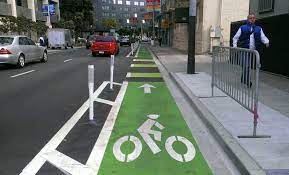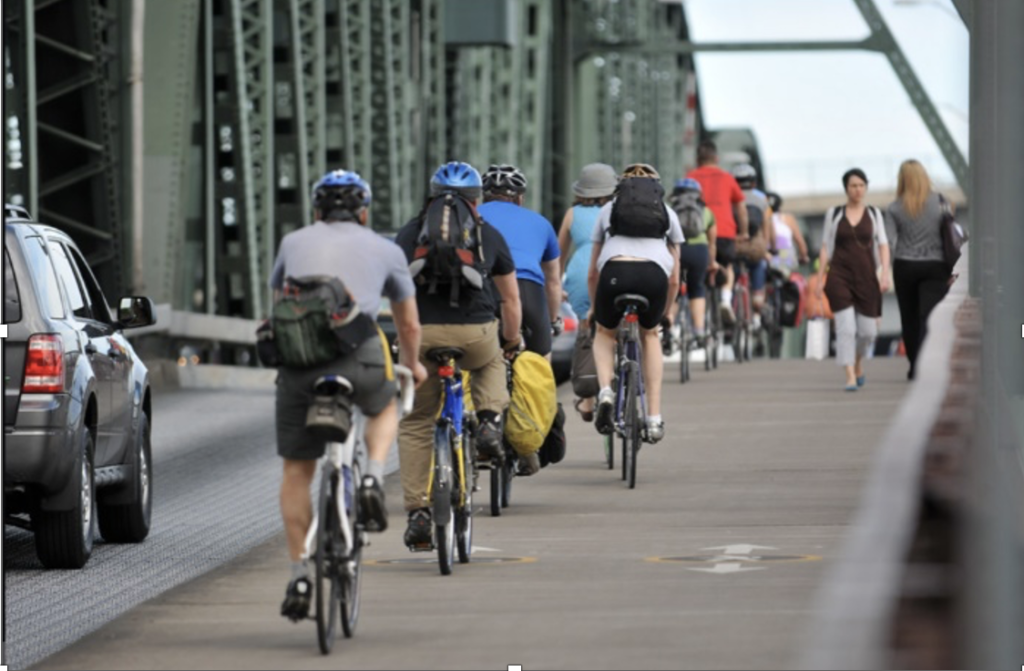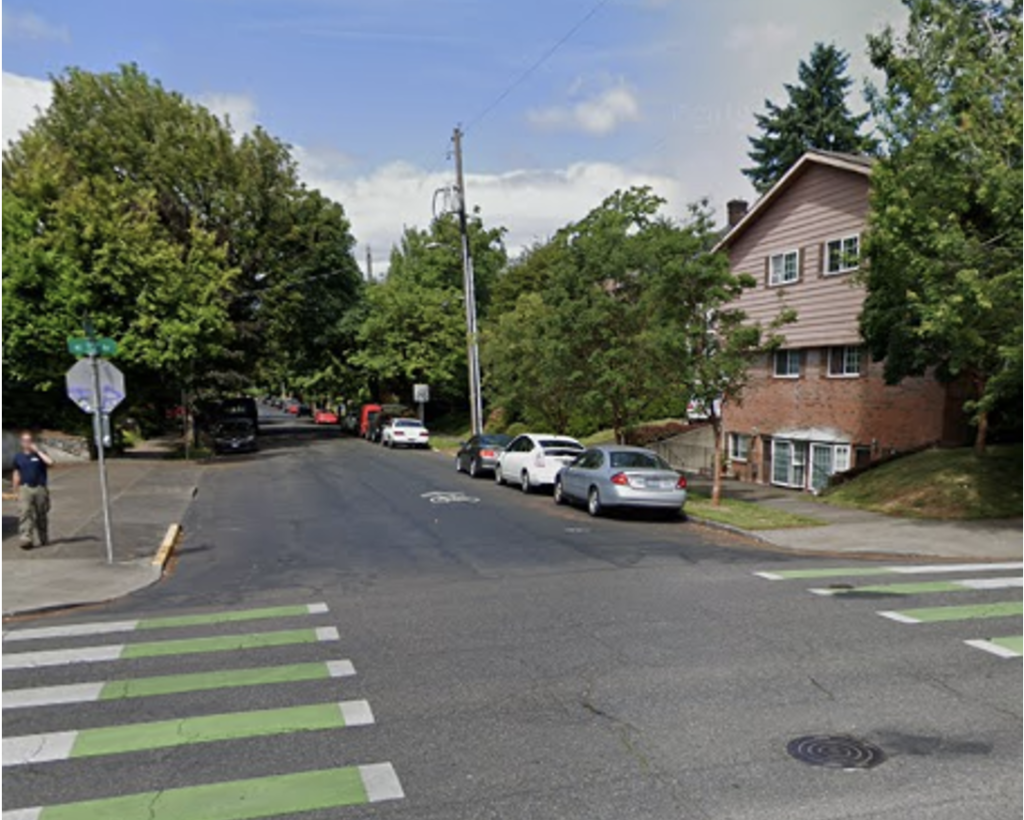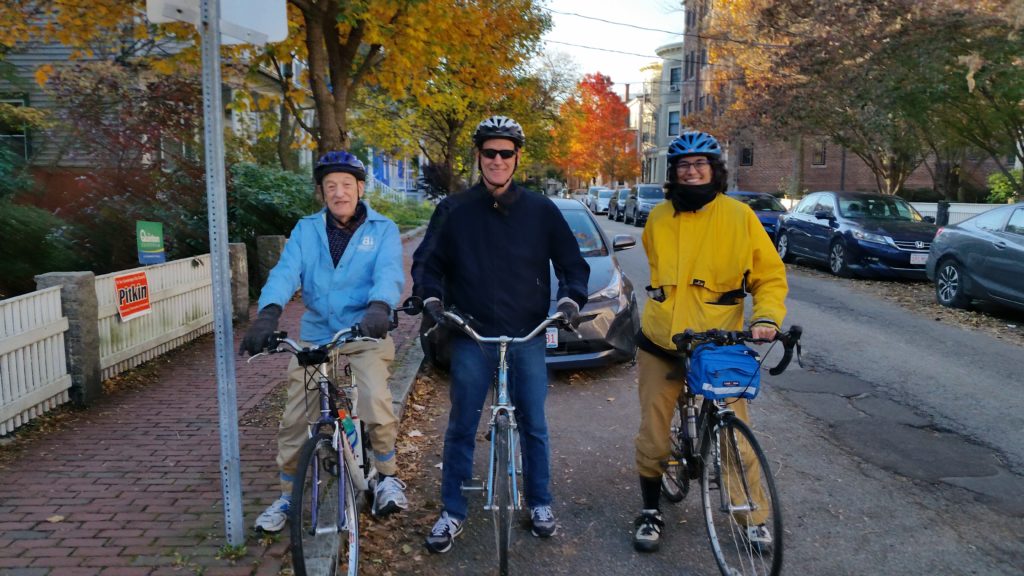Issues & Analyses: Mode Shift #2 -Supporting Sustainable, Equitable Transportation

Separated bike lane. Photo: National Department of Transportation
What Does It Look Like To Build A Robust Bicycle Network? Who Is It For?
In my first Mode Shift column, I laid out an overall vision for ways for Amherst and UMass to support sustainable and equitable transportation through a transportation mode shift. In this column, I tell a bit of my own story, which provides context for why I see a robust bicycle network as both a crucial and a possible part of a sustainable, equitable mode shift.
In 2009, as a recent transplant to Amherst, I wrote an email to a town planner saying that I thought Amherst could do better to build a robust bicycle network. In response, I got an email back from then-chair of the Public Transportation and Bicycle Committee, Fran Van Treese, inviting me to join the committee. Before Amherst, I lived in Oregon for seventeen years. Between 1991 and 2008, I had seen Portland and Eugene transform themselves into bike-friendly cities, where I and almost everyone I knew bike-commuted for work, school, shopping, and increasingly, to take our children to daycare. Now I was a UMass assistant professor and a single parent of a four-year-old, bringing my commitment to alternative transportation to Amherst. I found bike-commuting in Amherst more difficult than I thought it should be, especially in a town that was built with a downtown, streets, and distances sized long before cars.
I didn’t grow up in Oregon, but rather Cambridge, Massachusetts. As a high school student in the early 1980s I biked on Cambridge Street to my volunteer job at the Boston Museum of Science. That was long before Cambridge Street had its controversial bike lanes, and long before anyone wore bike helmets. I shudder now to think about my parents allowing their child and her vulnerable teenager brain to bike through Boston traffic, as cars wove in and out of double-parked spaces on that busy street. But somehow, I survived.
A decade later in the early 1990s, I was in Portland, Oregon. Things were only somewhat better than Boston. I biked downtown in a 30-minute commute through Southeast Portland. The busiest stretch was over the Hawthorne Bridge. The sidewalk was narrow, and it was there that angry Portlanders did one thing better than Bostonians: they expected and taught basic bike-passing etiquette, yelling at me “Slow down!” and “Ring your bell!” (rather than the less constructive responses that might be more common in Boston traffic).

Then I witnessed a more fundamental shift in Portland. Spurred on by an effective advocacy group, and an increasingly supportive city government, in 1999 the county re-did the Hawthorne Bridge sidewalks, expanding them from 4 to 10 feet, with a lane for bicyclists and a lane for pedestrians.
Other infrastructure innovations proceeded apace. Portland designated a series of minor artery streets as bike routes, adding bike route sharrows, signs, and crossings. It added protected bike lanes to a number of major artery streets. At some crowded intersections, the city added green lights just for bikes while cars were stopped, thus ending dangerous right turns into bicyclists. It put bike racks on buses and inside the new light rail. By the turn of the millennium Portland had a robust network of bikeways reaching almost every corner of the city.

To Portland’s south, Eugene, where I started graduate school in 1998, created and expanded a network of bike-and-pedestrian riverside paths and car-free bridges. It narrowed many of its main artery driving lanes to 9.5 feet to allow more room for bike lanes and to provide a road geometry that slowed cars. Bus drivers learned to drive in the narrower lanes.
Well beyond Portland and Eugene, there is ample evidence and now plenty of popular education to show that infrastructure that is safe and connected helps more people bike safely, and helps more people shift to biking for basic commuting. This article from the Urban Institute, for example, summarizes with useful graphics and examples, some key evidence that “protected bike lanes improve the economies of surrounding neighborhoods, improve safety, and expand ridership.”
Infrastructure is crucial, but not enough by itself. Portland’s change in infrastructure was related to a vision of who and what a bike network was for. Portland bike activists and city government leaders had a vision of bicycling not as a recreational activity for a select few athletic, spandex-wearing professionals building their recreational prowess, but rather of a utilitarian, inexpensive, healthy, and yes, sometimes fun, way for people of all shapes, sizes, ages, communities, and socioeconomic circumstances to get from place to place. The Community Cycling Center worked and works to rebuild discarded bikes, give away bikes to those who can not afford them, teach people to repair their own bikes, and teach people of all ages and circumstances how to ride bikes—including through Portland’s streets. The city helped seniors learn to ride adult tricycles. Parents learned to bike with their kids. The city also educated car drivers, pedestrians, and bicyclists how to share the road with consistent signage, lane markings, and public education.
By 2017, before the pandemic, almost 23,000 workers biked to work in Portland —a higher percentage than any other major city in the US. That number had more than tripled since 2000. Over one-third of those commuters were women.
That is a mode shift.
What are the lessons for Amherst? Not everything from Portland and Eugene translates directly. Amherst has worse winter weather, more hills, some narrower streets, few grids where a parallel street can provide a safe bike route alternative to a main artery, lower population density, and more deciduous trees. Still, many of Portland’s and Eugene’s innovations do translate (and rainy weather most of the year gives Portland and Eugene bicyclists a challenge we don’t have). As I emailed in 2009, Amherst can do better. Next time I’ll come back to: what would a robust bicycling network look like in Amherst, and how do we create one?


And #2 continues to make a good case! But, alas….
Since 1990s we’ve been seeking motor-traffic lanes narrower than the “standard” 11 or 12 (or more) foot width. For example, when the Coolidge bridge was rebuilt around the end that decade, James Lowenthal (then-MassPV head) and your-truly (then-AmherstPTBC chair) held regular meetings with then-state-Senator Stan Rosenberg, imploring his help to persuade then-MassHighWay to include 4.5 foot-wide bike lanes in both directions on the bridge and the 4-lane parts of Route 9 in Hadley (by painting each motor-traffic lanes about a foot narrower).
Today there’s hope at the state level: maybe now that MassHighWay has been rebranded MassDoT (having gained experience working with us to redesign and reconstruct the Norwottuck Rail Trail a decade ago) we have a better chance?
The existence of the NRT had been used as an excuse by MassHighWay back then, but also keep in mind that our PVTA buses are nearly 10 feet wide — including their mirrors — and many trucks using Route 9 are even wider.
But at the local level a lot of work remains to be done persuade those in positions of authority that bicycles are vehicles, and in particular that things like
• on-street bike-lanes on all arterials
• contra-flow bike-lanes on one-way-for-motor-vehicle streets
• bike boulevards
and similar easy-to-implement (or modify: it’s mainly just paint!) infrastructure
might take priority to even more parking (and ever faster, more dangerous roads).
And here’s the “mammoth” in the room: what will it take to persuade the vast majority of local car drivers — our own UMass students, Eve — to “kick the car habit” (or at least indulge in moderation)?
I hope one of your future columns will explore that!
I am so grateful for this column. There are exciting mode shifts in progress around the world but I think it is difficult for many of us to imagine transportation systems that are not centered on automobiles. Eve is offering us opportunities to think about how things could be different and better.
We did a study tour in Cuba in 2002 and we spent a lot of time talking with our hosts about adjustments that Cubans had to make during the Special Period in the Time of Peace , which began in 1991 after the dissolution of the Soviet Union, and which cut Cuba off from most of the supply chains on which they had long depended. One thing that became scare in the special period was petroleum and private vehicle use nearly came to a halt. Public transportation was overwhelmed. And so the government went out and bought something like a million Chinese bikes and distributed them among the population. And people started biking to work, sometimes over incredible distances on these one speed bicycles. And folks lost lots of weight and got into shape and the health of the nation greatly improved and work continued in the relative absence of automobiles. We struggle to imagine such a dramatic change in our modes of transport and that’s an obstacle – the limitations of our imagination. One host told us he couldn’t imagine riding 15 miles to work on a bike. And yet he, and many of his neighbors did. Of course when the nation regained access to oil, bicycle use plummeted, but the special period illustrated a possibility realized that was outside of most folks’ imagination.
So glad to see this Eve, looking forward to future installments! I (very occasionally) bike my commute from the Western Hilltowns to Hampshire College. It amazes and saddens me that the worst part of the 20-mile trek is not the 1,000+ feet of elevation to climb on Route 66, but the five nerve-wracking miles on Bay Road after jumping off the Norwottuck Rail Trail. Safe and enjoyable bike connectivity between all of the Five Colleges (including the more rural reaches of South Amherst and South Hadley) would be a great start.